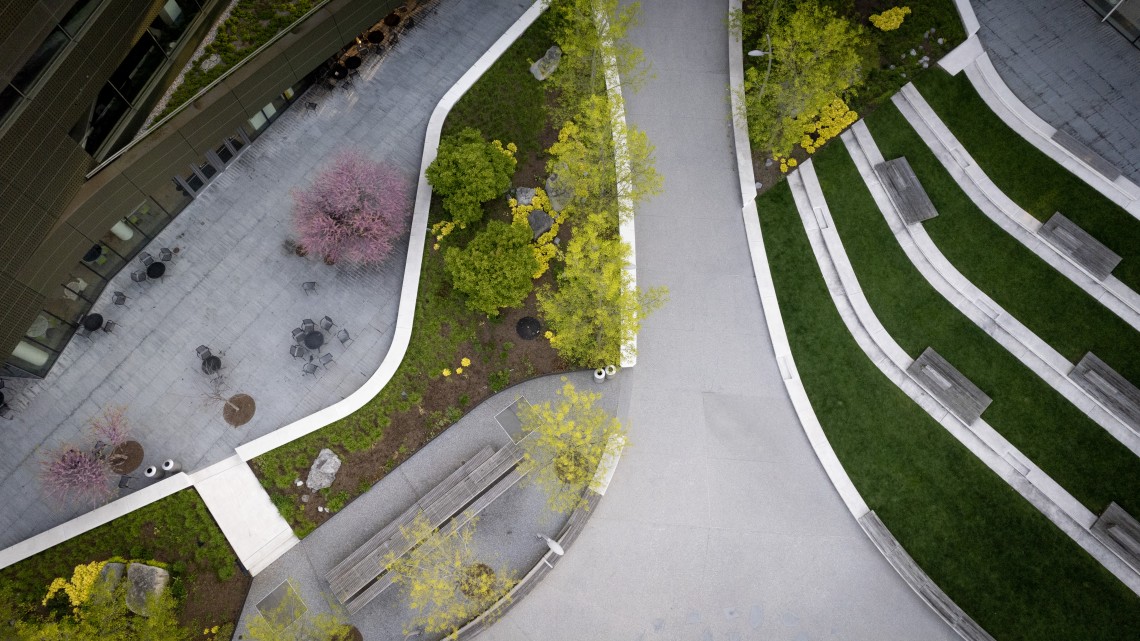
Pictured above are strategic vegetated channels, known as bioswales, and porous paving at the Cornell Tech campus which allow clean, naturally filtered rainwater to soak into the earth — stopping trash and grime from flowing into the East River and doubling as flower beds that add to the beauty of campus.
News directly from Cornell's colleges and centers
Building a Sustainable Future: How Cornell Tech’s Campus Design Prioritizes Eco-Friendly Innovations
As Cornell Tech looks toward future development, it aims to go beyond simply reducing its environmental impact. By continuing to innovate and incorporate new sustainable technologies, the New York City campus is a model for how urban spaces can thrive in harmony with natural systems, serving as a living laboratory for sustainable development in one of the world’s most iconic cities.
Walking across the Cornell Tech campus in the fall, visitors are bound to notice leaves changing color and Manhattan’s dramatic skyline rising across the East River, sights that have become the signature of the Roosevelt Island campus. Less apparent but just as much a part of Cornell Tech is the cutting-edge sustainable design woven into campus infrastructure. From thoughtful landscaping choices to high-tech energy saving techniques, sustainability is not just an extra at Cornell Tech – it’s what makes the campus run.
“When you see the campus without knowing the entire story, it’s easy to have no idea what’s going on under the surface,” said Biyoung Heo, Landscape Architect, from the firm Field Operations, which led the master landscaping planning and design for the campus. “It’s only when you get to talking about all of the innovations does the full picture of sustainability on campus become clearer and the entire vision starts to make sense. Everything from the recycled water to the bioswales are intentional and help make the campus incredibly environmentally friendly.”
Looking deeper into the campus’s innovative design features, such as the Emma and Georgina Bloomberg Center’s photovoltaic roof and rainwater collection system, it’s clear that efficiency, adaptive reuse of resources, and environmental stewardship are integrated into every aspect of the infrastructure. LEED certifications adorn buildings across the campus, best exemplified by “The House at Cornell Tech”, which, when it was unveiled in 2017, was the tallest and largest residential building built to Passive House standards – which requires reducing heating and cooling energy consumption by more than 75% compared to average new construction – in the world.
Underneath a long picnic bench area adjacent to the Bloomberg Center sits a 40,000-gallon rainwater collection tank. But this system does double duty: once water is collected, it is then cleaned and used in the Bloomberg Center’s refuse and nearby irrigation systems, reducing the need for municipal water sources. Additionally, the campus employs geo-exchange heating and cooling, an innovative and still uncommon system that drastically reduces annual energy consumption and cost, again, utilizing resources available right on the Island. In the colder months, the system through convection pulls warmth from the earth and, in warmer months, does the reverse.
While students, faculty and staff, as well as visitors and members of the Roosevelt Island community, interact with the campus every day, thoughtful, and oftentimes unnoticed details make a big difference when it comes to sustainability and resilience. The campus has been intentionally built several feet above sea level, which protects against flooding and also promotes intentional drainage. The small collections of flowers and shrubs on the perimeter of campus might be mistaken for decorative gardens, but are actually strategically placed and intentionally designed bioswales. The vegetated pathways act as natural filtration systems, capturing and cleaning stormwater runoff and holds it on site. , This reduces the rainwater impact on the city’s stormwater infrastructure while promoting biodiversity and natural filtration systems on campus.
The campus’s sustainable ethos extends to its material-sourcing practices as well. Rocks and stones used across the site, the porous pavement meant to assist with water draining and the strategically placed boulders, are sourced from a single quarry near Nyack, N.Y., reducing transportation-related energy and carbon use.
The commitment to sustainability doesn’t stop at infrastructure. Now, In addition to its technological advancements and infrastructure, Cornell Tech is working to embed sustainability as a core value in its campus culture. Through educational initiatives and local involvement from the Roosevelt Island Community, the campus is fostering a sense of shared responsibility for environmental stewardship among students, faculty, and the local community. As part of this effort, Andrew Fowler, Capital Project Manager at Cornell Tech, has also embraced a new and less formal position as a member of the institution’s sustainability committee. The committee, seeks to generate awareness and foster a culture of sustainability through initiatives within the campus community.
“We are all striving for continued improvement as our collective understanding of sustainability evolves,” said Fowler. “What this work really requires to be successful is to bring in more people to join our community. It is a process that requires everyone in order to change a culture.”
Media Contact
Get Cornell news delivered right to your inbox.
Subscribe

